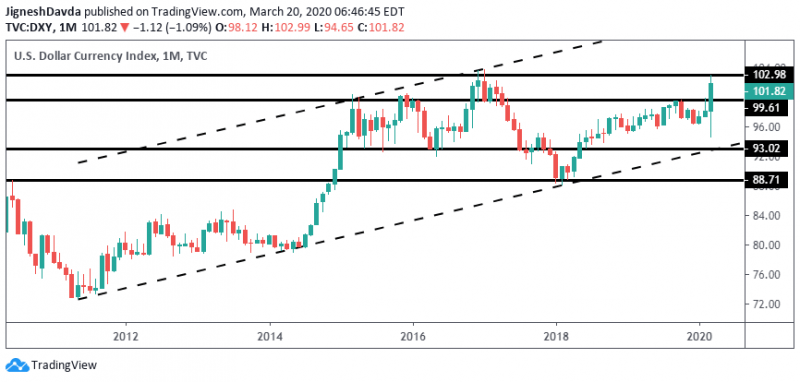The US Dollar Is Dangerously Close to a Breakout
The US dollar, against a basket of currencies, went from a loss of 3.5% for March last Monday to showing a nearly 5% monthly gain at one point yesterday. With the dollar index (DXY) pulling back from some major resistance, the question at this stage is, will it break out?
The resistance level in DXY that has caused the turn lower since the start of Asian trading on Friday falls at 103.00 and was responsible for triggering a turn lower at the start of 2017. This turn ended up evolving into a 13-month downtrend for a loss of 15%.
The monthly chart shows that the dollar has been in an uptrend since 2008. A bullish continuation would not be surprising. Although a few analysts have argued against further gains in the dollar.

Arguments Against A Dollar Breakout
One theory has been that the dollar might mean-revert, which is all too common in the FX markets. A great example of mean reversion can be seen in EUR/USD which has been unable to trade in a sustained trend after the initial fall in the first half of 2018.
The main argument against this, however, is that there is a catalyst in place at this time.
The Coronavirus has led to a sharp sell-off in the equity markets. Initially, investors rushed to safe-haven assets such as gold and the Japanese yen. This is no longer the case.
The USD/JPY currency pair has recovered a bulk of its losses in March, indicating investor preference over the dollar versus the yen. What’s unusual about this move is that the currency pair typically has a strong correlation with equities and that it has broken from this correlation during a time the correlation typically would have gained strength.
In a similar fashion, gold prices have not just given back gains for the month but declined to three-month lows this week. On a monthly chart for spot gold, a reversal pattern is in the making.
Another argument is that officials may try and intervene in the markets to stop the rapid dollar rise. This is certainly a possibility, and there are several methods officials can employ to stop the dollar rise dead in its tracks.
Technical Considerations for the Dollar
Traders positioned in the dollar should keep a close eye on the 103 level in the dollar index. A bullish break above it could lead to an acceleration in upside momentum. In such a scenario, it would not be surprising to see a quick move to parity in EUR/USD.
The commodity currencies were under pressure this week and AUD/USD, NZD/USD, and USD/CAD appear especially sensitive to further dollar gains. It should be noted, however, that all of these currencies have fallen recovered since Thursday. If the three major commodity currencies are able to hold on to gains for the day thus far, these pairs will start next week out with a reversal candlestick formation on a daily chart which stands to trigger further dollar weakness.
To the downside in the dollar index, the 99.61 level remains critical over the next week or two. This same level held the index lower last year and ahead of the sharp turn lower in February. Bulls will want to defend the level in the event of a pullback to maintain the broader bullish momentum.
In the event the dollar index does break out, a potential target might be 109 which marks the 76.4% Fibonacci retracement measured from the 2001 high to 2008 low. The target reflects a roughly 6% upside potential.
This article was originally posted on FX Empire

 Yahoo Finance
Yahoo Finance 